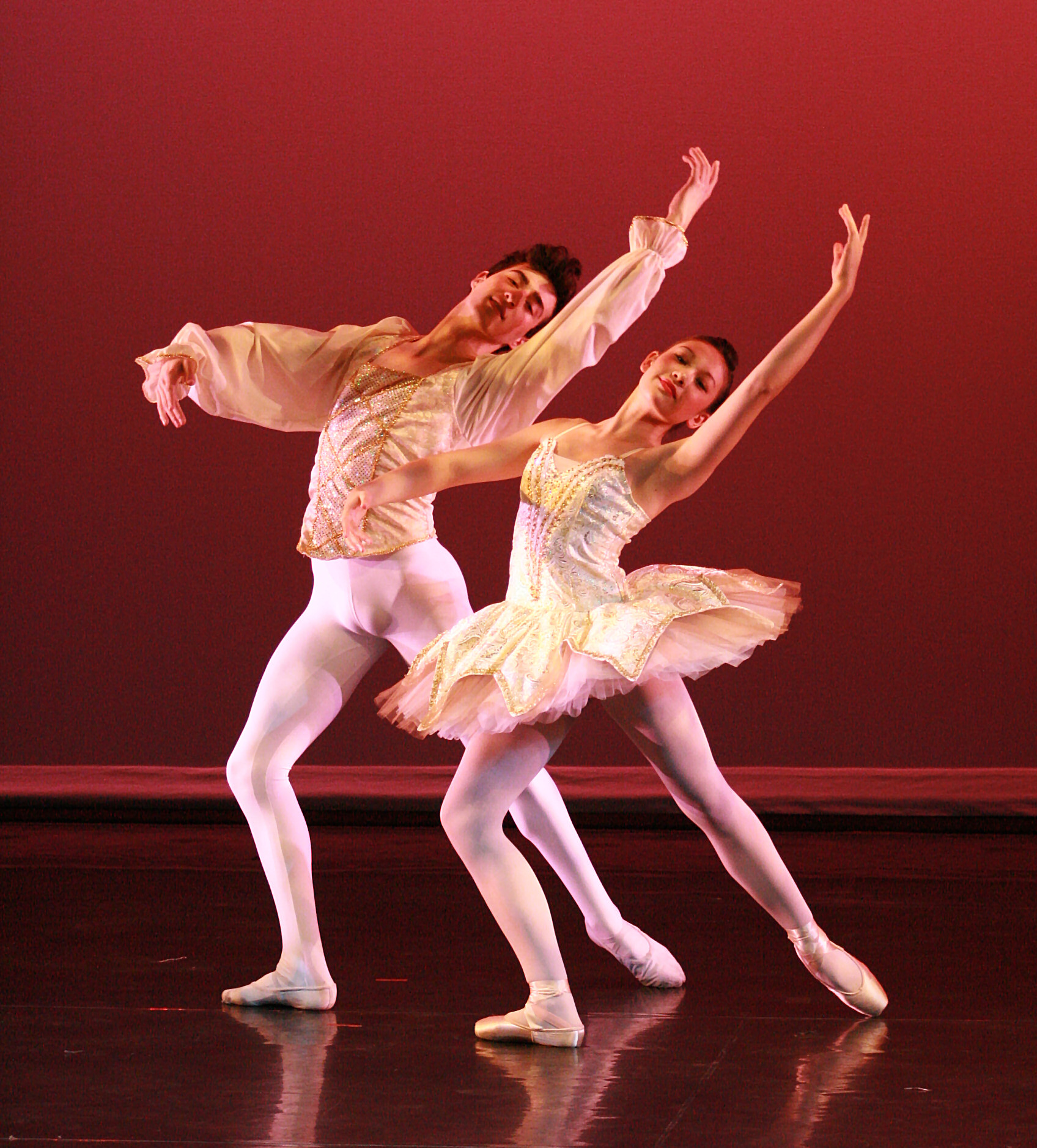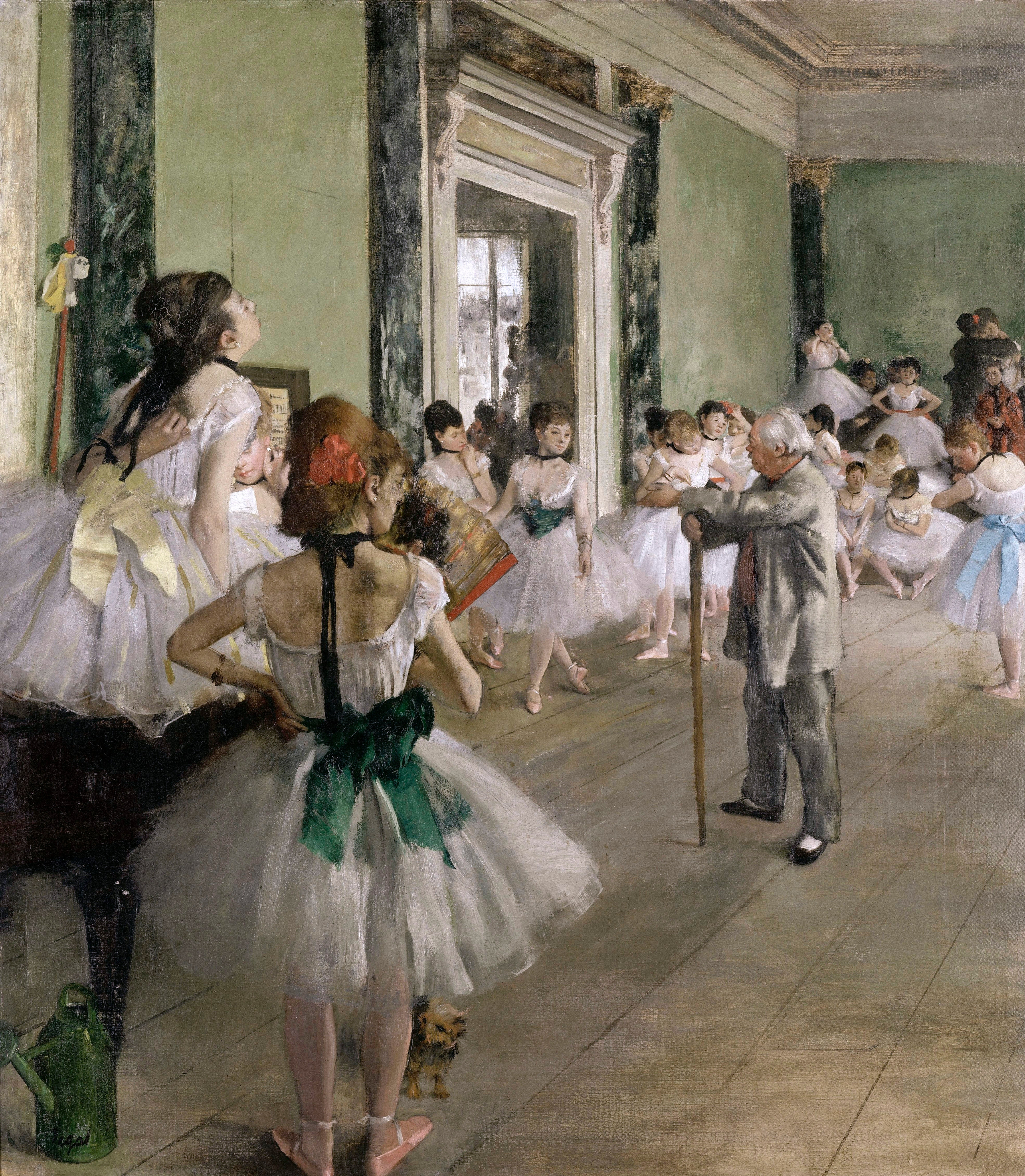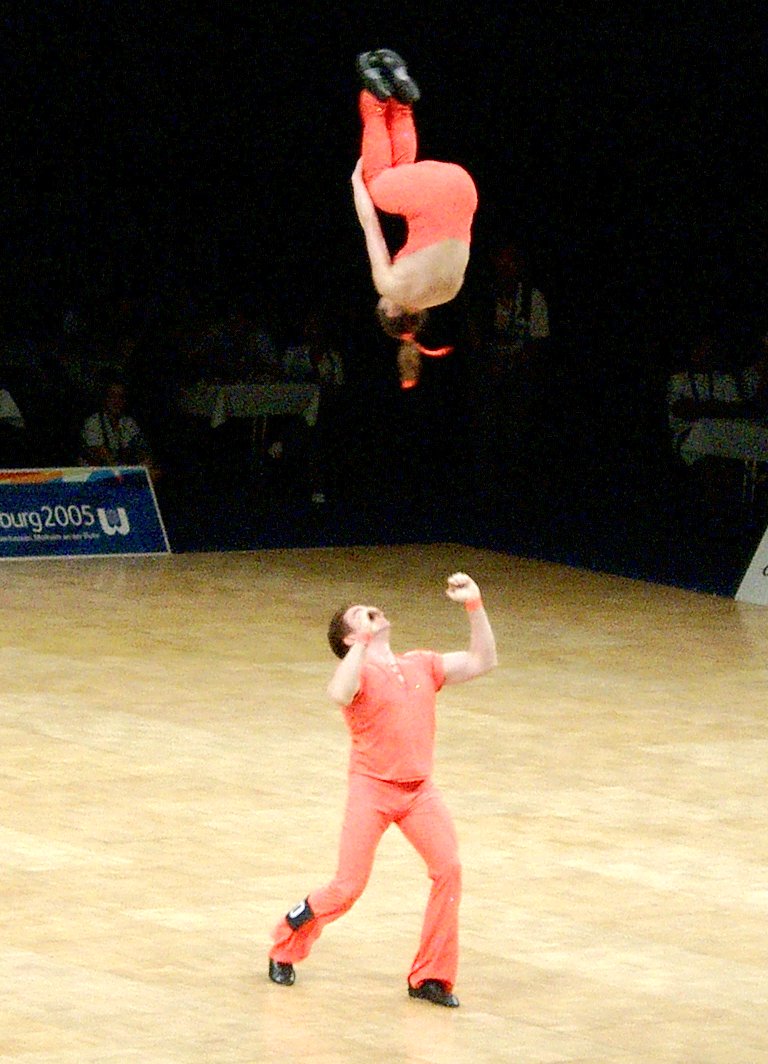|
Dance Partnering
Dance partnering is dancing performed by two or more dancers (traditionally a male leader and a female follower, though forms such as Contact improvisation and Fusion dance have troubled this traditional dynamic), that strive to achieve a harmony of coordinated movements. Many forms of dance rely on the application of partnering dance techniques that facilitate coordinated movements by dancers. Dance partnering technique appears in various forms in many types of dance and is an essential part of all partner dances. Scholars of dance, including anthropologist Cynthia Novack, philosopher Ilya Vidrin, ethnomusicology David Kaminsky, cognitive scientist Michael Kimmel, among others, have written about techniques of partnering in different forms. Technique A variety of partner dance techniques are employed in dance partnering. Typically, the technique used for a particular dance style is generally focused on either communication between partners or physical support of one partner by ... [...More Info...] [...Related Items...] OR: [Wikipedia] [Google] [Baidu] |
Pas De Deux
In ballet, a ( French, literally "step of two") is a dance duet in which two dancers, typically a male and a female, perform ballet steps together. The ''pas de deux'' is characteristic of classical ballet and can be found in many well-known ballets, including ''Sleeping Beauty'', ''Swan Lake'', and '' Giselle''. It is most often performed by a male and a female (a ''danseur'' and a ''ballerina'') though there are exceptions, such as in the film '' White Nights'', in which a ''pas de deux'' is performed by Mikhail Baryshnikov and Gregory Hines. ''Grand pas de deux'' A ''grand pas de deux'' is a structured ''pas de deux'' that typically has five parts, consisting of an ''entrée'' (introduction), an ''adagio'', two variations (a solo for each dancer), and a ''coda'' (conclusion). It is effectively a suite of dances that share a common theme, often symbolic of a love story or the partnership inherent in love, with the dancers portraying expressions of affectionate feelings an ... [...More Info...] [...Related Items...] OR: [Wikipedia] [Google] [Baidu] |
Australian Ballet
The Australian Ballet (TAB) is the largest classical ballet company in Australia. It was founded by J. C. Williamson Theatres Ltd and the Australian Elizabethan Theatre Trust in 1962, with the English-born dancer, teacher, repetiteur and director Dame Peggy van Praagh as founding artistic director. Today, it is recognised as one of the world's major international ballet companies and performs upwards of 150 performances (both in Australia and overseas) a year. History The roots of the Australian Ballet can be found in the Borovansky Ballet, a touring repertory company founded in 1940 by the Czech dancer Edouard Borovansky. Borovansky had been a dancer in the touring ballet company of the famous Russian ballerina Anna Pavlova and, after visiting Australia on tour with the Covent Garden Russian Ballet, he decided to remain in Australia, establishing a ballet school in Melbourne in 1939, out of which he developed a performance group which became the Borovansky Ballet. ... [...More Info...] [...Related Items...] OR: [Wikipedia] [Google] [Baidu] |
Jitterbug
Jitterbug is a generalized term used to describe Swing (dance), swing dancing. It is often synonymous with the lindy hop dance but might include elements of the Jive (dance), jive, east coast swing, collegiate shag, Charleston (dance), charleston, Balboa (dance), balboa and other swing dances. Swing dancing originated in the African-American communities of New York City in the early 20th century. Many nightclubs had a whites-only or blacks-only policy due to Racial segregation in the United States, racial segregation, however the Savoy Ballroom in Harlem had a no-discrimination policy which allowed whites and blacks to dance together and it was there that the Lindy Hop dance flourished, started by dancers such as George Snowden and Frank Manning. The term jitterbug was originally a ridicule used by black patrons to describe whites who started to dance the Lindy Hop, as they were dancing faster and jumpier than was intended, like "jittering bugs", although it quickly lost its nega ... [...More Info...] [...Related Items...] OR: [Wikipedia] [Google] [Baidu] |
Jive (dance)
The jive is a dance style that originated in the United States from African Americans in the early 1930s. The name of the dance comes from the name of a form of African-American vernacular slang, popularized in the 1930s by the publication of a dictionary by Cab Calloway, the famous jazz bandleader and singer. In competition ballroom dancing, the jive is often (mistakenly) grouped with the Latin-inspired ballroom dances, though its roots are based more on swing dancing than Latin dancing. History To the players of swing music in the 1930s and 1940s, jive was an expression denoting glib or foolish talk. American soldiers brought Lindy Hop The Lindy Hop is an American dance which was born in the African-American communities of Harlem, New York City, in 1928 and has evolved since then. It was very popular during the swing era of the late 1930s and early 1940s. Lindy is a fusion of .../ jitterbug to Europe around 1940, where this dance swiftly found a following among the yo ... [...More Info...] [...Related Items...] OR: [Wikipedia] [Google] [Baidu] |
Ballet
Ballet () is a type of performance dance that originated during the Italian Renaissance in the fifteenth century and later developed into a concert dance form in France and Russia. It has since become a widespread and highly technical form of dance with Glossary of ballet, its own vocabulary. Ballet has been influential globally and has defined the foundational ballet technique, techniques which are used in many other dance genres and cultures. Various schools around the world have incorporated their own cultures. As a result, ballet has evolved in distinct ways. A ''ballet'' as a unified work of art, work comprises the choreography (dance), choreography and music for a ballet production. Ballets are choreographed and performed by trained ballet dancers. Traditional classical ballets are usually performed with classical music accompaniment and use elaborate costumes and staging, whereas modern ballets are often performed in simple costumes and without elaborate sets or scenery ... [...More Info...] [...Related Items...] OR: [Wikipedia] [Google] [Baidu] |
Acro Dance
Acro dance is a style of dance that combines classical dance technique with acrobatic elements. It is defined by its athletic character, its unique choreography, which blends dance and acrobatics, and its use of acrobatics in a dance context. It is a popular dance style in amateur competitive dance as well as in professional dance theater and in contemporary circus productions such as those by Cirque du Soleil. This is in contrast to acrobatic, artistic and rhythmic gymnastics, which are sports that employ dance elements in a gymnastics context under the auspices of a governing gymnastics organization (such as FIG) and subject to a Code of Points. Acro dance is known by various other names including ''acrobatic dance'' and ''gymnastic dance'', though it is most commonly referred to simply as ''acro'' by dancers and dance professionals. Acro is an especially challenging dance style for dancers as it requires them to be trained in both dance and acrobatic skills. History Ac ... [...More Info...] [...Related Items...] OR: [Wikipedia] [Google] [Baidu] |
Rock And Roll (dance)
Acrobatic rock and roll (spelled ''rock'n'roll'' by its organizing body, the World Rock'N'Roll Confederation) is a fast, athletic, physically demanding form of partner dance that originated from Lindy Hop but has evolved to a choreographed sport, often done in formal competition. It is danced by both couples (usually of mixed gender) and groups, either all-female or four to eight couples together. History From swing dance, which had come into being around 1920, there emerged Lindy Hop, the first partner dance ever to feature acrobatic elements, which was later modified to suit faster music, spawning dance steps to accompany rock 'n' roll as that genre developed. Today's rock and roll dance has gone far beyond these origins, especially in its gymnastic moves. Technique and basics The Rock and Roll form's specifics vary across the world, but its kick-step footwork style starts with the 6-basic step: Leader starts with left foot kick ball change, kick step (left), kick ... [...More Info...] [...Related Items...] OR: [Wikipedia] [Google] [Baidu] |
Lead (dance)
In some types of partner dance, lead and follow are designations for the two dancers' roles in a dance pairing. The leader is responsible for guiding the couple and initiating transitions to different dance steps and, in improvised dances, for choosing the dance steps to perform. The leader communicates choices to the follower, and directs the follower by means of subtle physical and visual signals, thereby allowing the pair to be smoothly coordinated. The amount of direction given by the leader depends on several factors, including dance style, social context of the dance, and experience and personalities of the dancers. Traditionally, the male dance partner was the leader and the female dance partner was the follower. In the 21st century, it has become increasingly common to see partnerships that buck this dynamic, particularly in more socially progressive dance styles. Gender roles Traditionally, the male dance partner is the leader and the female dance partner is the follow ... [...More Info...] [...Related Items...] OR: [Wikipedia] [Google] [Baidu] |
Dance
Dance is an The arts, art form, consisting of sequences of body movements with aesthetic and often Symbol, symbolic value, either improvised or purposefully selected. Dance can be categorized and described by its choreography, by its repertoire of movements or by its History of dance, historical period or List of ethnic, regional, and folk dances by origin, place of origin. Dance is typically performed with Music, musical accompaniment, and sometimes with the dancer simultaneously using a musical instrument themselves. Two common types of group dance are Concert dance, theatrical and Participation dance, participatory dance. Both types of dance may have special functions, whether social, ceremonial, Competitive dance, competitive, Erotic dance, erotic, War dance, martial, Sacred dance, sacred or Liturgical dance, liturgical. Dance is not solely restricted to performance, as dance is used as a form of exercise and occasionally training for other sports and activities. Dance perf ... [...More Info...] [...Related Items...] OR: [Wikipedia] [Google] [Baidu] |
Ballroom Dance
Ballroom dance is a set of European partner dances, which are enjoyed both socially and competitively around the world, mostly because of its performance and entertainment aspects. Ballroom dancing is also widely enjoyed on stage, film, and television. ''Ballroom dance'' may refer, at its widest definition, to almost any recreational dance with a partner. However, with the emergence of dance competition (now known as Dancesport), two principal schools have emerged and the term is used more narrowly to refer to the dances recognized by those schools. The International School, originally developed in EnglandFranks A.H. 1963. ''Social dance: a short history''. Routledge & Kegan Paul, London. and now regulated by the World Dance Council (WDC) and the World DanceSport Federation (WDSF), is most prevalent in Europe. It encompasses two categories, Standard and Latin, each of which consist of five dances—International Waltz, International Tango, International Viennese Waltz, Intern ... [...More Info...] [...Related Items...] OR: [Wikipedia] [Google] [Baidu] |
Ilya Vidrin
Ilya Vidrin is an academic research-practitioner notable for his work on the theory and practice of partnering. He is Assistant Professor of Creative Practice Research and Core Faculty at the Institute of Experiential Robotics at Northeastern University and a Research Affiliate at Harvard MetaLab. Professional life Ilya pursued undergraduate studies in Cognitive Neuroscience and Rhetorical Theory at Northeastern University. Ilya completed three years of intensive clinical research training in the Neurology Department at Beth Israel Medical Deaconess Center, with a focus on non-pharmacological therapies for cognitive and neurodegenerative disorders. Ilya went on to graduate school at Harvard University, earning a Master’s Degree in Education with a focus on Human Development and Psychology. At Harvard, Ilya worked on experimental research projects investigating cognitive models of creative practice and empathy, including biofeedback technology, Therapeutically Active Digital Med ... [...More Info...] [...Related Items...] OR: [Wikipedia] [Google] [Baidu] |





